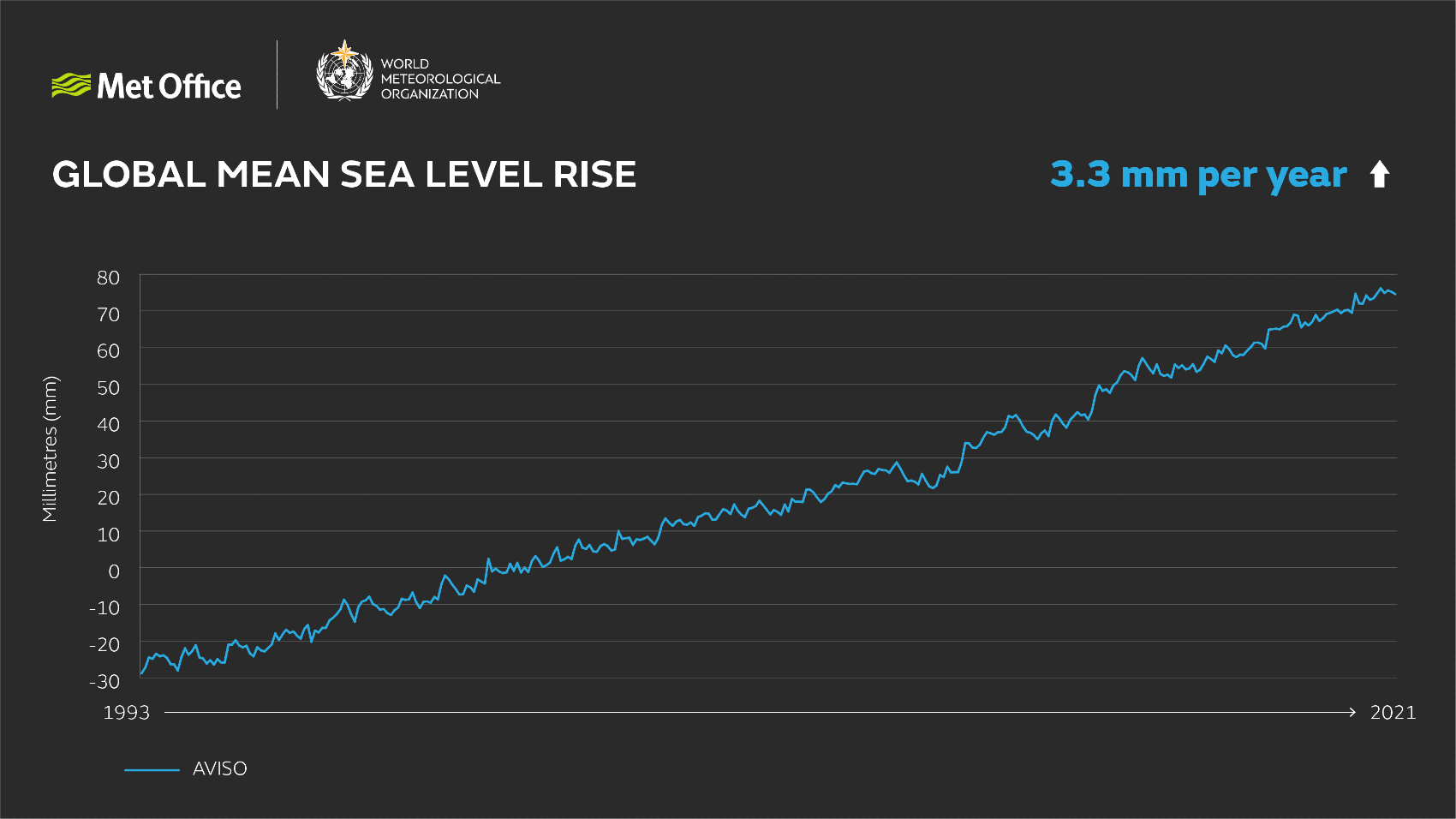Key climate change indicators break records in 2021
Author: Press Office
11:53 (UTC+1) on Wed 18 May 2022
Key climate change indicators – including atmospheric concentrations of carbon-dioxide, sea level, and ocean heat – set new records in 2021.
The WMO State of the Global Climate in 2021 report – the production of which was led by the Met Office - confirms that the past seven years have been the warmest seven years on record. 2021 was “only” one of the seven warmest because of a La Niña event at the start and end of the year. This had a temporary cooling effect but 2021 was warmer than any year prior to 2015. The average global temperature in 2021 was about 1.11 (± 0.13) °C above the pre-industrial level [1850-1900].
The WMO State of the Global Climate report complements the IPCC Sixth Assessment report, which includes data up to 2019. The new WMO report provides information and practical examples for policy-makers on how the climate change indicators outlined in the IPCC reports played out during the recent years globally and how extremes have been felt at national and regional level in 2021.
Sea level rise is one of four #ClimateChange indicators that broke records in 2021. #StateOfClimate
— World Meteorological Organization (@WMO) May 18, 2022
More👉https://t.co/SR7bhQ6t7i pic.twitter.com/p2XXbWP1YJ
The WMO State of the Global Climate report will be used as an official document for the UN Climate Change negotiations known as COP27, to take place in Egypt later this year.
Professor Albert Klein Tank is Director of the Met Office for Climate Science and Services. He said: “The seven years between 2015 and 2021 have been the warmest since the industrial revolution, with 2016 being the warmest year on record.
“Although the planet’s surface temperature last year didn’t break the 2016 record, the upper two kilometres of the ocean reached the warmest level in 2021. Around 90 per cent of the heat from climate change is accumulated in the ocean and last year’s record signals that climate change is progressing.
“The build up of heat in the ocean and climate system means it is almost inevitable that one of the next five years will be the warmest on record for global surface temperature, beating 2016.”
Dozens of experts contribute to the report from Member-States including National Meteorological and Hydrological Services (NMHSs) and Global Data and Analysis Centres, as well as Regional Climate Centres, the World Climate Research Programme (WCRP), the Global Atmosphere Watch (GAW), the Global Cryosphere Watch and the EU’s Copernicus Climate Change services as well as many United Nations partners.
Key findings
The atmospheric concentration of carbon-dioxide (CO2) reached a new high in 2021 with 419.13 parts per million recorded at Mauna Loa in Hawaii in May 2021.
The global annual mean temperature in 2021 was around 1.11 ±0.13 °C above the 1850-1900 pre-industrial average, less warm than some recent years owing to cooling La Niña conditions at the start and end of the year. The most recent seven years, 2015 to 2021, are the seven warmest years on record.
Ocean heat was record high. The upper 2000m depth of the ocean continued to warm in 2021 and it is expected that it will continue to warm in the future – a change which is irreversible on centennial to millennial time scales. All data sets agree that ocean warming rates show a particularly strong increase in the past two decades. The warmth is penetrating to ever deeper levels. Much of the surface ocean experienced at least one ‘strong’ marine heatwave at some point in 2021.
Ocean acidification. The ocean absorbs around 23% of the annual emissions of anthropogenic CO2 to the atmosphere. This reacts with seawater and leads to ocean acidification, which threatens organisms and ecosystem services, and hence food security, tourism and coastal protection. As the pH of the ocean decreases, its capacity to absorb CO2 from the atmosphere also declines. The IPCC concluded that “there is very high confidence that open ocean surface pH is now the lowest it has been for at least 26,000 years and current rates of pH change are unprecedented since at least that time.”
Global mean sea level reached a new record high in 2021, and increased at an average 4.5 mm per year over the period 2013 -2021. This is more than double the rate of between 1993 and 2002 and the change in rate is mainly due to the accelerated loss of ice mass from the ice sheets. This has major implications for hundreds of millions of coastal dwellers and increases vulnerability to tropical cyclones.






